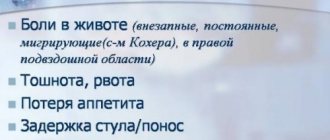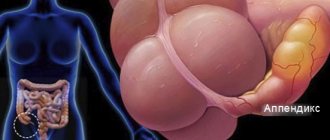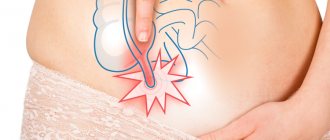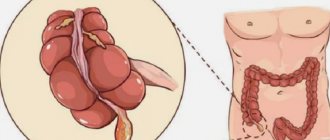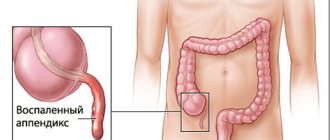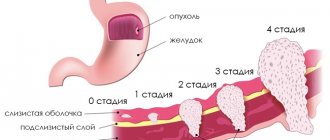Where is the appendix located and why is it needed?
The appendix is located in the lower abdomen, approximately midway between the navel and the right ilium. The location of the appendix can vary: the appendix can be raised to the right hypochondrium or lowered into the lower part of the pelvis. The appendix is tubular in shape, its length ranges from four to 15 cm, and its diameter is up to ten mm.
The appendix is needed for the formation of immunity and intestinal biocenosis, as well as for regulating the level of bifidobacteria and lactobacilli in the intestines. In addition, the organ performs secretory and protective functions. Thanks to the powerful lymphatic apparatus, the vermiform appendix regulates the outflow of lymph in the intestines.
Diseases with similar symptoms
It is not always possible to recognize appendicitis at the first examination without additional tests and examinations. This happens only because the primary symptoms of the appendix are very similar to the signs of other diseases that painfully “give” to the same area.
So, here is a small list of such diseases:
- inflammation of the ovaries, fallopian tubes or uterus;
- pyelonephritis;
- renal colic;
- Crohn's disease (also called terminal ileitis);
- ulcer and its perforation;
- enterocolitis and colitis of varying degrees;
- inflammation of small intestinal nodes;
- inflammation of the testicle;
- rupture, sometimes stretching, of the anterior abdominal muscles and more.
Ultrasound of the pelvic and abdominal organs does not always help to make an accurate diagnosis. This happens due to the fact that something can be viewed on an ultrasound machine or simply not seen due to the imperfection of the technology or the skills of the specialist. Only laparoscopy can give a 100% result in making a diagnosis.
Signs of appendicitis
The primary sign of appendicitis is severe abdominal pain and persistent vomiting. Other symptoms of appendicitis:
- abdominal muscle tension;
- chills;
- increase in body temperature up to 38°C;
- loss of appetite;
- weakness;
- dry mouth;
- tachycardia (increased heart rate).
Appendicitis in children is manifested by diarrhea, sometimes with mucus in the stool. With appendicitis in men, spontaneous tightening of the right testicle and discomfort when retracting the scrotum are observed.
Special forms of inflammation
The clinical picture of appendicitis depends on the atypical position of the appendix, changes in the patient's response due to age, pregnancy, and medication use. It is impossible to recognize a special form on your own; a specialized examination is required.
| Form of inflammation | Clinical picture |
| Retrocecular appendicitis | Pain, muscle contraction, painful extension of the limbs in the thigh when examining the patient on the left side |
| Laterocecal appendicitis | Pain on the right side of the abdomen (due to muscle contraction, pain may radiate to the lumbar region) |
| Pelvic appendicitis | Localization of pain near the symphysis, inguinal ligament, painful hip rotation, dysuric problems, diarrhea |
| Mesocoelial appendicitis | Pain around the navel, often without muscle contraction |
| Left-sided appendicitis | Pain, muscle contraction in the left hypogastrium, clinically simulating diverticulitis. Often it is possible to understand that it is the appendix that is inflamed only by examining the abdomen using imaging methods |
| Senile appendicitis | Possible absence of classic symptoms, in particular muscle contractions; inexpressible pain. The course of the disease is more severe, purulent complications and perforations are common |
Testing for inflammation in old age is difficult due to the body's reduced ability to respond to it. In children, the problem is inappropriate reporting of symptoms.
Acute appendicitis
Acute appendicitis develops quickly and has pronounced symptoms. There are four forms of acute appendicitis:
- gangrenous appendicitis (the inflammatory process penetrates the abdominal area, necrosis of the appendix occurs);
- catarrhal appendicitis (inflammation is localized only in the mucous membrane of the appendix);
- perforated appendicitis (the wall of the appendix is destroyed, its contents enter the abdominal cavity);
- phlegmonous appendicitis (the inflammatory process spreads to the wall of the appendix).
Acute appendicitis can be complicated by perforation of the appendix and a purulent process. Purulent appendicitis is deadly because the accumulation of pus can cause the appendix to rupture. The contents of a burst appendicitis enter the abdominal cavity, which leads to sepsis (blood poisoning).
What is it about?
In order for the statistics reflecting the frequency of deaths from appendicitis to change, it is necessary for ordinary people to have a better understanding of the risks of this disease. Some suffer for hours from pain localized in the appendix area, others endure such painful sensations for days, hoping that they will disappear on their own. If you start the process, peritonitis will begin - an inflammatory abdominal process caused by the thinning of the inflamed tissues and their destruction, during which the contents of the intestinal tract spill into the cavity. At the moment of rupture, the pain suddenly becomes very strong, covers the abdomen completely, and the patient’s condition becomes worse. The abdomen is swollen, the patient vomits, the discharge smells like feces, and the patient regurgitates.
You can suspect a worsening case if the patient is motionless, the lips are especially dry, and the skin is pale. The thermometer shows fever, observation of breathing - increased frequency. The patient's abdomen is tense. If the condition is particularly severe, delirium may occur. If such phenomena are observed, the doctors have only one solution - urgent surgery. This approach is the gold standard of modern medicine. Timely surgery is a virtually guaranteed guarantee of a speedy full recovery. True, it is impossible to remove the appendix in vain, without inflammation, since the organ is an element of the nervous system and participates in the functioning of the gastrointestinal tract. If, due to the inflammatory process, the appendix can no longer perform the functions provided by nature, removal of the organ is the most effective treatment option in modern conditions.
How is appendicitis determined?
Only a doctor can diagnose appendicitis. At the first symptoms of inflammation of the appendix, you should immediately consult a doctor. The consultation with the surgeon includes an examination and medical history. Appendicitis is determined by studying symptoms and comprehensive diagnosis.
You can determine appendicitis yourself by taking the fetal position (lying on your right side and pulling your legs towards your body). A decrease in pain in this position indicates inflammation of the appendix.
About the numbers
As statistical studies show, over the past few decades the number of complications accompanying inflammation of the appendix has noticeably decreased. The incidence of deaths has also decreased significantly. Today, mortality from appendicitis is estimated at two hundredths of a percent among the total number of people with inflammation of the appendix. However, such indicators do not characterize the most economically prosperous areas, which are characterized by rather low infrastructure development. An amazing paradox arises: the better a person’s standard of living, the more prosperous the area, the more negligent the person is about his health, believing that it is never too late to visit a doctor.
How is appendicitis removed?
Removal of appendicitis (appendectomy) is performed through open surgery or through a minimally invasive procedure called laparoscopic appendectomy. In open surgery, the appendix is cut out through a small incision in the lower right side of the abdomen. The intervention is carried out under intubation (endotracheal) anesthesia: the patient is immersed in a state of deep medicated sleep with complete relaxation of the muscles. The operation lasts up to one hour.
During laparoscopic surgery, the appendix is removed through a puncture in the navel. The advantages of laparoscopic appendectomy include low trauma and rapid rehabilitation. The scar from appendicitis removal after minimally invasive surgery is almost invisible. Laparoscopy minimizes possible postoperative complications. After a laparoscopic appendectomy, the risk of adhesions after appendicitis, which can lead to the sticking of internal organs, is much lower.
Treatment: surgery or not?
In recent years, doctors have not only been trying to inform the general public whether it is possible to die from appendicitis, as well as the need for urgent and adequate treatment of inflammation associated with these risks, but are also working towards finding new methods and approaches to combat the disease. In European countries and the United States, scientists annually publish scientific materials containing information about people who underwent emergency surgery, as well as those who received antibiotic treatment. In 2012, information became known about 900 adults who suffered from uncomplicated inflammation of the appendix. Of these, 430 received surgical treatment, 470 received conservative treatment. Among the second category, 63% were completely cured, the rest still required surgery. The likelihood of complications for the second group was estimated to be one third less than for those who were immediately sent for surgery.
Also in 2012, the results of the observation of Swedish doctors became known. The probability of relapse during antibiotic treatment over an annual period is estimated at 10-15%. About 80% of people whose condition allowed conservative treatment were completely cured. Finnish researchers worked in 2015 with a group of 530 people. They were randomly assigned to treatment. 274 people received surgery, one died, 99.6% were successfully healed. Another 256 people were treated with antibiotics and observed by doctors for about a year. 72.7% were healed, 27.3% required surgery. No complications were recorded due to late surgery.
Laparoscopic appendectomy
Laparoscopy is performed for uncomplicated inflammation of the appendix. Minimally invasive surgery for appendicitis is performed under intubation (endotracheal) anesthesia.
The evening before the appendectomy and on the day of the operation, you should not eat, and two hours before the intervention you should not drink. Before performing a laparoscopic appendectomy, the surgeon will refer you to a therapist for an initial consultation and order laboratory tests.
A blood test for appendicitis is necessary to determine the total number of leukocytes, an increase in which indicates suppuration of the appendix. Ultrasound of the abdominal organs with appendicitis shows the position of the appendix relative to other organs, as well as enlargement or thickening of the walls of the appendix.
Other tests before laparoscopic appendectomy include:
- IgM ELISA test for Covid-19;
- HIV antibody test;
- analysis for blood group and Rh factor;
- analysis for total antibodies to syphilis;
- tests for hepatitis B and C viruses;
- clinical urine analysis;
- coagulogram;
- electrocardiogram.
During a laparoscopic appendectomy, the surgeon makes a puncture in the navel, inserts gas, a camera and instruments, and examines the abdominal cavity. The doctor removes the appendix through the umbilical port and loads it into a container, then stitches it up. After surgery, the appendix is sent for analysis for cancer cells.
Operation: to do or not?
In the 19th century, doctors already knew whether it was possible to die from appendicitis and learned to associate the symptoms of the disease with a specific organ. True, in 1839, when an official description of the disease had already been compiled, they still believed that the operation gave a dubious result. This was due to the lack of analgesics and antibiotics. General anesthesia first became available in 1846. From this point on, the operation becomes a less dangerous procedure. True, at that time the doctors did not yet know that it was necessary to remove the small appendage, so they opened the cavity and cleaned out the pus from the hole. In the 1880s, information appeared about the successful removal of inflamed areas.
In 1886, Fitz published a report that made the term “appendicitis” generally accepted and widespread. He also described the clinical manifestations and also recommended surgical treatment. From that moment to this day, when diagnosing the disease, the optimal treatment option is surgery. Without surgery, the mortality rate was previously estimated at 67%. In our country, Troyanov performed the first operation in 1890 in St. Petersburg.
Recovery after appendicitis
The first one or two days after laparoscopic appendectomy, the patient is in the hospital under the supervision of a doctor. Two to three days after the intervention, the doctor removes the stitches and gives individual recommendations for the recovery period. In the first 12 hours after appendectomy you cannot eat, you are only allowed to drink. Then you must follow a special diet for two weeks.
Appendicitis after surgery may hurt for five to ten days. On average, recovery from appendicitis lasts up to two weeks.
Diet after appendicitis
The diet after removal of appendicitis involves split meals (food can be taken in small portions five to six times a day). 12 hours after the appendectomy, you are allowed to drink a little low-fat chicken broth or sweet fruit jelly. On the second day after surgery, you can also include mashed potatoes, boiled rice in water, boiled and pureed chicken meat, as well as natural yogurt in your diet.
Four days after appendicitis, you can eat steamed meat and fish cutlets, semi-liquid porridge with a small amount of butter, pureed cereal soups in low-fat meat broth or water, soft-boiled eggs and steamed omelettes.
The diet after removal of the appendix must be followed for two weeks. The doctor will prescribe recommendations for further nutrition.
Popular questions
1. On which side is the appendix located?
The appendix is located on the lower right side of the abdomen, approximately between the navel and the right pelvic bone.
2. How long does the operation to remove appendicitis take?
Laparoscopic surgery to remove appendicitis lasts, on average, about an hour. During the intervention, appendicitis is removed through pinhole punctures on the anterior abdominal wall.
3. What should you not eat after appendicitis?
After appendicitis, foods high in fiber and fat should be excluded from the diet. Prohibited foods after appendicitis also include legumes, mushrooms, cabbage, fatty, smoked and fried foods, confectionery, mayonnaise, sauces, vinegar, nuts, dumplings, fast food and chocolate. In addition, the diet after appendicitis involves avoiding the consumption of alcoholic and carbonated drinks, coffee and strong black tea.
4. What can appendicitis be confused with?
If the appendix is descended into the lower part of the pelvis, appendicitis in women can be confused with adnexitis (inflammation of the appendages) or ovarian cyst, and in men with inflammation of the bladder. If the appendix is located under the liver, the pain is localized in the right hypochondrium, as a result of which appendicitis can be confused with acute cholecystitis.
Symptoms similar to appendicitis also appear in other diseases. Appendicitis can be confused with mesadenitis (inflammatory disease of the lymph nodes of the small intestine), renal and hepatic colic, which also causes abdominal pain, nausea and vomiting.
0
1
0
Article rating:
4 out of 5 based on 3 ratings
Author: Vovk Valery Anatolyevich
Surgeon. Doctor of Medical Sciences. Highest category. Work experience 26 years.
Treatment: curious to know
Sometimes, due to health reasons, ordinary people are forced to delve into what is called appendicitis.
Many people know on which side a person’s appendix is located – usually on the right; information about the possibility of an atypical structure of internal organs is no less widely known. It is known that the only way to cure the disease is to undergo surgery. This scares many people; they really want to get rid of the disease by taking a miracle pill or several.
From the history of mankind it is known that for the first time they tried to treat appendicitis in the time of Avicenna. It was he who diagnosed the disease of the Bukhara ruler and removed the appendage. This is not known for certain, but some believe that the patient survived, although reliable antibiotics were not yet known at that time. For hundreds of years, scientists have tried to study appendicitis. Sometimes it was confused with muscle inflammation and uterine diseases. Attempts were made at conservative treatment with gastric lavage, enemas and opium tinctures. As a result, the patient died, although not in such painful agony.

